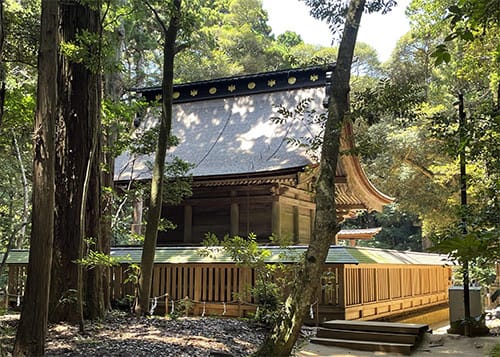


この鹿島神宮の奥宮社殿は、慶長10年(1605)に徳川家康が関ヶ原戦勝の御礼に現在の本殿の位置に本宮として奉納したものを、その14年後に新たな社殿を建てるにあたりこの位置に遷してきたものとされる。
この社伝を信じれば、建築としての経歴は400年を超える。こちらの奥宮を前回見たのは2014年のはずで、そのときは屋根が苔むしていた。下の写真はその当時のもの。森の中にその精気を受けたようなすばらしい「呼吸感」が伝わってきた記憶がある。それが今回は令和の大改修工事の結果、檜皮葺屋根修繕が施されて、建築創建時の雰囲気が再生されている。
どちらの雰囲気も甲乙付けがたいけれど、建築の長期保存ということを考えればこのように補修を心がけて行くということは当然のことと受け止められますね。一方わたしの個人的な好みとしてはコケ大好き人間で自宅でも石膏ボードの素地仕上げ外壁部分にコケが生えてきているのがウレシイ変人っぷりなので(笑)、苔むした屋根というのは深くこころに沈殿させられるものがある。
鳥居があって、拝殿・本殿が一体化した簡素な建築。正面の鳥居左右に屋根の着いた塀が回されているけれど、その寸法感覚、バランス感覚に工匠たちの美的感受性が表現されていると感じる。



家康の時代の工匠たちの感覚が残されているということになりますが、その後の東照宮のようなゴテゴテの装飾性はほとんど見られず、いかにも戦国武将として信長・秀吉とはちがう家康らしい実利性が感じられる。家康は本拠の江戸城も当初はあまり装飾性を意識せずに簡素に作ったと言われるけれど、この奥宮でもそんなかれの個性が伝わってくるような気がする。
今回再訪したのだけれど「もう一回見てみたいな」と事前からこころに浮かんでいたのは、この奥宮だった。そこまで深く考えたことはなかったけれど、たぶんこころは正直に記憶再生させていたのだろう。
結局、建築とか住宅とかの価値感でいちばん重要なのは、愛着感というモノなのではないだろうか。
建築にはさまざまな目的があり施主としてはそういう思いを実現したいと思う。それが叶えられた後、その建築は使い続けることに大きな意味が移っていく。まずは機能性であり毎日使って動線計画とかの「使い勝手」の日常生活があり、そこで寝て暮らしさらに人間としてさまざまな人生模様が沈殿していく。そしてジワジワと沸き起こって来るものが人生と建築の相関的な愛着感。
そういう時間を積層後、なおこころに響き合ってくるものが愛着というものの実質なのではないだろうか? 苔好き人間のつぶやき(笑)。・・・
English version⬇
Kashima Jingu Shrine, Okugu Shrine, dedicated in honor of the victory in the Battle of Sekigahara.
When I revisited Kashima Jingu Shrine, I thought, "I want to see this shrine again. It was a pleasure to see the architecture again. The design sense of simplicity and elegance. I was very happy to see it again.
It is said that the inner shrine pavilion of the Kashima Jingu Shrine was dedicated by Tokugawa Ieyasu in 1605 as the main shrine to express his gratitude for the victory at Sekigahara, and was moved to this location 14 years later when a new shrine pavilion was built.
If this shrine legend is to be believed, its architectural history is over 400 years old. The last time I saw this Okumiya was supposed to be in 2014, when the roof was mossy. The photo below is from that time. I remember that I could feel a wonderful "breathing" sensation as if the forest was filled with the spirit of the shrine. This time, as a result of a major renovation in 2022, the cypress bark roof has been repaired, and the atmosphere of the original building has been restored.
It is hard to say which is better, but considering the long-term preservation of the building, it is only natural that repairs should be made in this manner. On the other hand, I personally love moss, and I am happy to see it growing on the plasterboard exterior walls of my own house (laugh), so a mossy roof is something that deeply touches me.
The shrine is a simple structure with a torii gate, a hall of worship, and a main shrine all in one. The roofed walls on either side of the torii in front of the shrine express the aesthetic sensibility of the craftsmen in their sense of dimension and balance.
The design of this shrine preserves the sensibilities of the craftsmen of Ieyasu's time, but it shows little of the ornateness of the later Toshogu shrines, and instead shows the pragmatism of a warlord like Ieyasu, who differed from Nobunaga and Hideyoshi in his warlord status. It is said that Ieyasu built the Edo Castle, his home base, in a simple manner without much attention to ornamentation in the beginning.
I had already had the idea in my mind before my return visit that I would like to see this shrine one more time. I had never thought about it that deeply, but perhaps my mind was honestly replaying the memory.
In the end, I think the most important thing in the sense of value of architecture and housing is a sense of attachment.
Architecture has a variety of purposes, and the owner wants to realize those purposes. After that is accomplished, the architecture becomes more important in terms of its continued use. First of all, there is the functionality, the daily life of "usability," such as the flow line plan, which is used every day, and the various patterns of human life that are deposited there as people sleep and live. Then, slowly and gradually, a sense of attachment is generated that correlates life and architecture.
After accumulating such time, what still resonates in our hearts and minds is the substance of attachment. The musings of a moss-loving person (laughs). Laughs



















